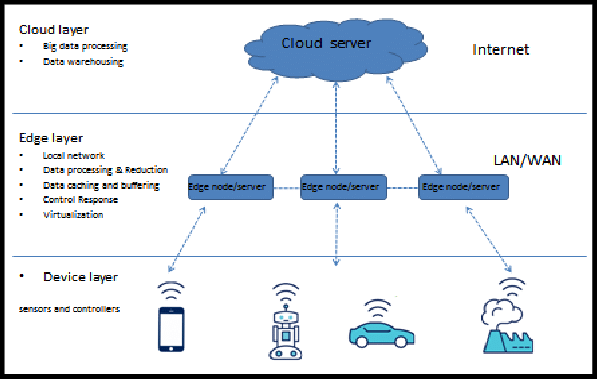You’ve heard how technology may help us lead more ecologically conscious lives. But did you know that edge computing, a contemporary technique, exists for carrying this out? It can significantly minimize waste and save energy by utilizing the data and power of your gadgets closer to home.
In this blog article, we’ll go deeper into the workings of this technology and its effects on the environment. This is what? By implementing an edge computing system for sustainability activities, you can reduce expenses while fostering a more cohesive community. Right, it sounds fantastic.
Learn more by continuing to read How can edge computing be used to improve sustainability?
What is edge computing, and How to Understand It?

Edge computing—ever heard of it?
It’s a distributed computing architecture that brings data processing and app logic closer to where it’s collected. In essence, it increases scalability and responsiveness by enabling processing directly at the network’s edge, where it is required.
Data analysis is, therefore, rapid, and decisions are made immediately. This is a significant issue for companies that use numerous different data sources.
Edge computing makes data analysis more reliable and efficient, improves performance, and saves a bundle on infrastructure costs and long-distance communication. Pretty sweet!
The Value of Sustainability in the Digital Age:
Businesses today are striving for sustainability in this digital age. They can totally achieve this by using edge computing! Using this strategy, they may lessen their dependency on data centers, reduce their influence on the environment, and maximize energy efficiency. Who wouldn’t desire it, right?
Edge computing also boosts the accuracy of analytics, reduces lag times, and streamlines data processing activities. It is also a game-changer for energy conservation because it processes and stores data locally.
Are you for real? This is especially important because data centers use 2% of worldwide energy!
So, How can edge computing be used to improve sustainability? With all these advantages, edge computing is quickly becoming a go-to solution for businesses keen on sustainable operations.
How can edge computing be used to improve sustainability?
There are several ways that edge computing can be applied to boost sustainability. The top few are listed below:
- Lower energy consumption:
Edge computing helps reduce reliance on data centers and energy consumption by processing data closer to its source. In the long run, this helps businesses save money by reducing waste.
- Faster data analysis:
Using edge computing, businesses may become more responsive and efficient, enabling quicker analytics and decision-making. Using fewer resources to complete a task enhances sustainability all around.
- Greater scalability:
With the help of edge computing, you can expand your network and add new devices without building new infrastructure.
Thanks to this flexibility while controlling expenditures, you can adapt rapidly to shifting business needs.
- Reducing Latency and Network Traffic:
Data can be processed more quickly and efficiently by moving the processing to the edge, which lowers network latency and traffic volume.
This reduces the resources required for communication and aids in maintaining data security by lowering security threats.
- Decentralization of Data Centers:
Businesses can lessen their dependency on cloud-based systems by using edge computing to decentralize data analysis and storage from distant data centers.
By doing so, the upkeep of massive data centers can be made more affordable, dependable, and less harmful to the environment.
- Renewable Energy Management:
Edge computing can also efficiently manage renewable energy sources. By detecting changes in weather patterns or grid conditions, edge computing can help optimize the use of renewable energy and better integrate it into existing energy systems.
- Strengthened privacy and security:
Did you know that edge computing can help businesses better secure themselves by processing data closer to the source?
A data breach or any other malicious action that could compromise sensitive information is less likely to occur.
- IoT and Edge Computing for Environmental Monitoring:
Edge computing can be used to monitor environmental conditions on a local level. This can help businesses identify areas of improvement and take measures to reduce their environmental impact.
For example, edge computing can track air quality in cities or monitor water levels in rivers and oceans, allowing for real-time monitoring and response.
- Improving disaster preparedness and management:
Enhanced disaster management and preparedness can be achieved with edge computing. You may swiftly identify any possible threats and take action to safeguard persons and property by combining data from sensors in the field.
- Sustainable Food Production through Agriculture:
Edge computing can improve sustainable food production. You may monitor crop development, water and soil conditions, and other agricultural characteristics by gathering data from sensors of farm systems. This enables more effective farming techniques.
- Sustainable supply chain management:
Using edge computing can run operations more effectively. By collecting data from distributed sensors, companies can identify any issues in their supply chain process and take steps to reduce waste and improve efficiency.
- Carbon Footprint Reduction:
Edge computing can reduce a company’s carbon footprint. You can track how much energy is being used by your devices and take action to maximize their usage by gathering data from distributed sensors. This helps firms become more environmentally responsible while simultaneously cutting costs.
You won’t believe it, but edge computing has the potential to completely alter the business landscape. Businesses can use sustainability to reduce costs, benefit the environment, and satisfy customers.
Hey! Did you realize that How can edge computing be used to improve sustainability?
Edge computing offers countless opportunities, from cost-saving to sustainability. Companies can improve their efficiency and customer service using the correct approach and plan.
Implementing Edge Computing for Sustainability: Obstacles and Limitations
Regarding sustainability, edge computing has several benefits. But there are still a few considerations that must be made.
Security procedures must be established, and data transportation must be made secure. We must invest in infrastructure to avoid unpleasant shocks and ensure everyone uses the appropriate app.
And finally, organizations must also ensure that their technology investments work with their current infrastructure and data centers.
Read Also: How will quantum computing affect artificial intelligence applications?
Read Also: What underlying concept is edge computing based on?
Read Also: What describes the relationship between edge computing and cloud computing?
How can we increase sustainability by fusing cloud and edge computing?
Combining cloud and edge computing might be the ideal answer for increasing your company’s sustainability. You may achieve higher efficiency that reduces costs, saves energy, and makes the most of your resources by using the potential of IoT devices and cloud computing services.
Thanks to the mix of edge and cloud computing, you can gain real-time insights into your data, which is even better. As a result, you may decide wisely to fulfill your sustainability goals without incurring additional energy expenses.
Takeaway:
In the end, we know edge computing is an excellent technology for eco-friendliness. Reducing lag, energy use, and dependence on the cloud can make collecting and analyzing data more efficient.
This all leads to better processes and less energy waste. It can even help green energy by readily connecting devices and sources. It’s super important for the planet’s future!
By using it, companies can be more sustainable while still doing what they do best.



